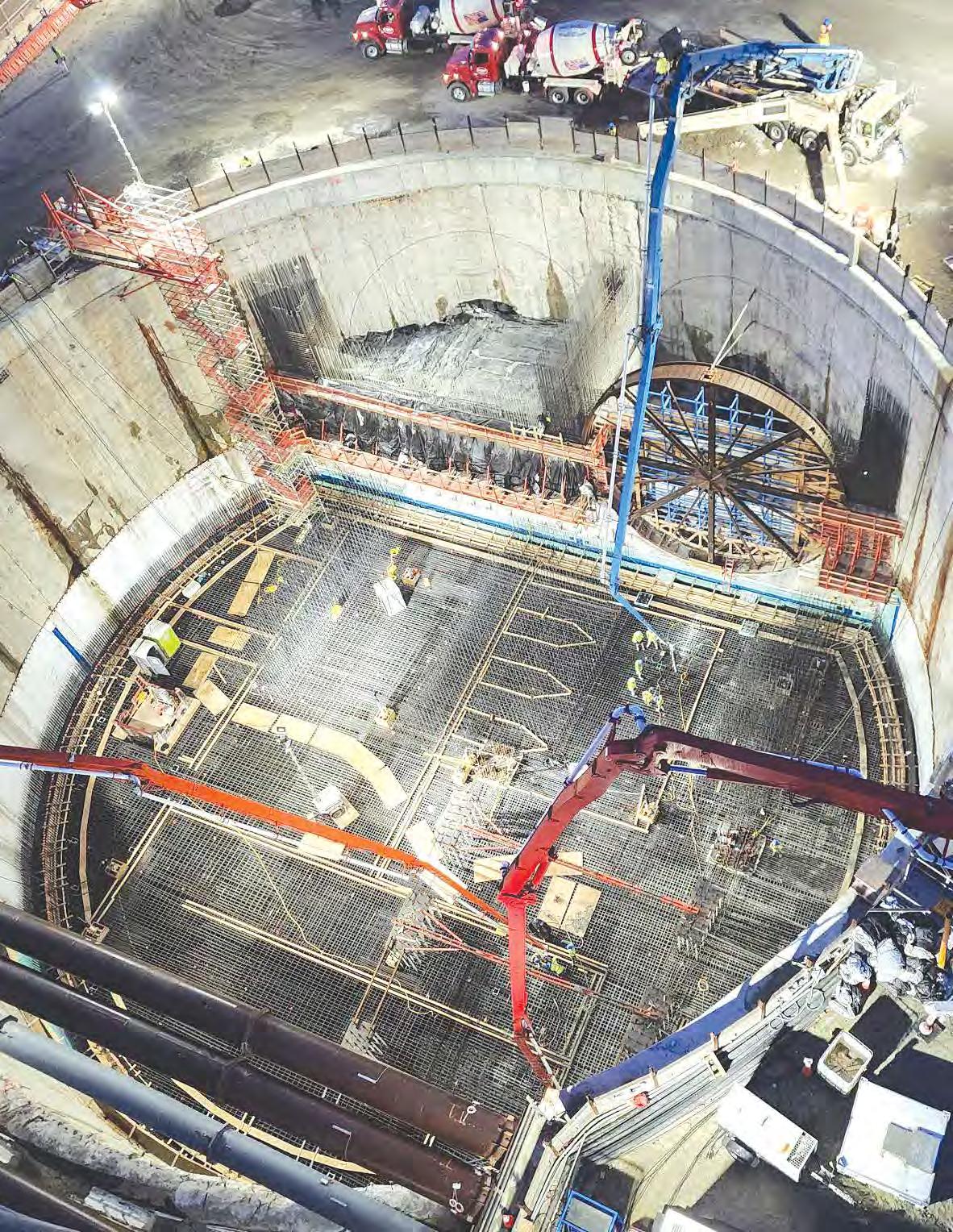

Project Director Message
Ryan Banas, PE
2023 was a monumental year for the Hampton Roads Bridge Tunnel Expansion Project as numerous pieces of new infrastructure took shape under and throughout the harbor. Crews made tremendous progress across all ten miles of the project, from continuing the first half of the Mallory Street Bridge, extensive road widening activities throughout Norfolk, and adding bridge decks to the trestles over the water. The project has had many historic firsts and this past year was no exception.
Constructing the North Island Receiving Pit base slab, nearly 200 team members participated in the largest continuous pour in VDOT history. We finished the year with a momentous milestone – Mary, our tunnel boring machine (TBM), completed 596 rings of the new tunnel, putting us halfway between Norfolk and Hampton on her first of two bores.

We anticipate 2024 will bring even more progress to the project as we prepare for Mary’s breakthrough on North Island, representing completion of the first tunnel in the next few months. Additionally, the traffic shift will allow the public to drive on the new North Trestle while traveling between Hampton and the North Island. Mallory Street is expected to shift into Phase II of its replacement and widened portions of the Willoughby Bay Bridge will start carrying traffic. 2024 is on pace to be the project’s biggest year yet!
The entire HRBT Expansion project team appreciates your continued interest and patience as we work to construct this much-needed infrastructure for the region. We look forward to sharing Mary’s continued progress and the many other milestones 2024 has in store. Don’t forget, you can help us deliver the project by doing your part: put down your phone, focus on the road, and stay alert in work zones!

Milestones for Miles of Work
Construction is fully underway across the entire HRBT Expansion Project. In Hampton, crews are finalizing the construction of the new southern portion of the Mallory Street Bridge and are expecting to shift traffic in spring 2024. Leaving the Hampton shoreline, the North Trestle bridges are taking shape on the water. The eastbound North Trestle will be ready to carry cars as early as spring 2024. Once traffic is shifted to the new bridge, crews can demolish the existing bridge.
On the North Island, work is advancing to prepare the receiving pit for Mary when the TBM breaks through in the spring.
As of January 2024, Mary has passed the deepest point of the tunnel, with more than half of the first tunnel installed as she contunues her journey to Hampton.
Another key milestone reached in December 2023 was the completion of more than 21,000 pre-cast tunnel segments at the Cape Charles plant. It was crucial that the tunnel segments were completed in advance so that segments could continuously be fed to Mary as she excavates.
On the Norfolk side of the project, crews completed pile-driving efforts for the eastbound Willoughby Bay Bridge and are building the bridge decks for the newly widened portion of the bridge. Pile-driving efforts continue for the westbound Willoughby Bay Bridge. The widening of Oastes Creek and Mason Creek bridges are visible as you travel eastbound with crews pouring new bridge decks nightly.

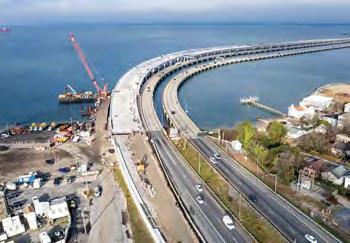
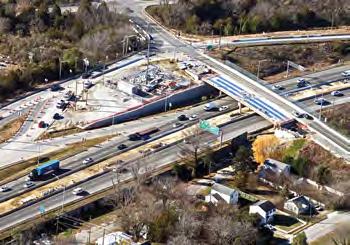
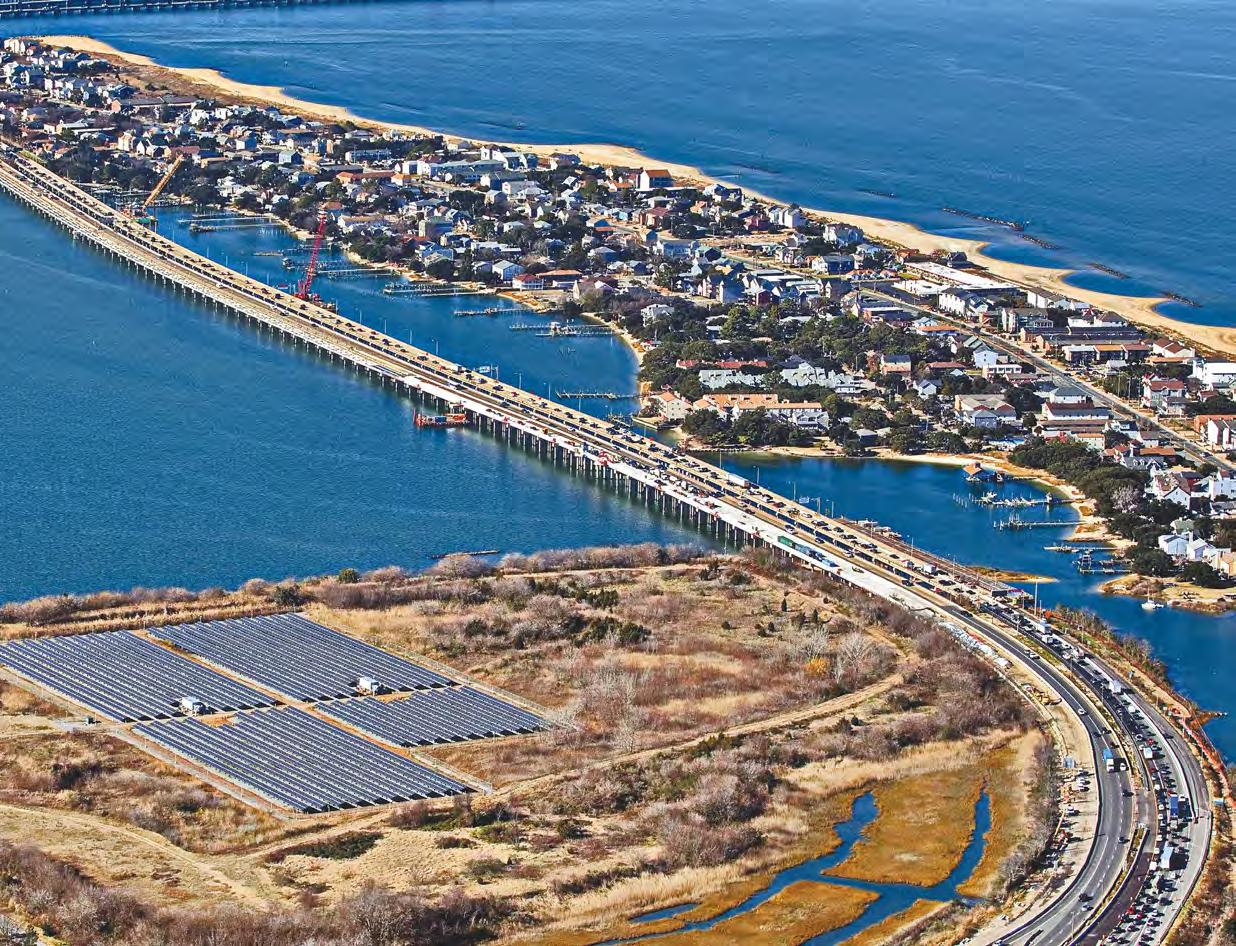
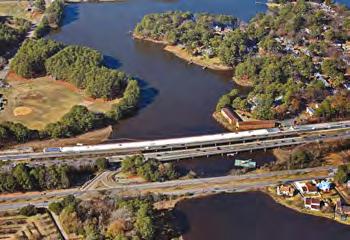
Largest Concrete Pour in VDOT History
The HRBT Expansion Project made history once again with the North Island receiving pit. In November 2023, nearly 200 personnel assisted with the largest continuous concrete pour in VDOT history to create the base slab for the receiving pit. For just over 31 consecutive hours, concrete truck after concrete truck delivered a continuous supply of concrete to the North Island. In total, 584 truckloads were needed to place 5,480 cubic yards of concrete to form the nine-foot-thick base slab.
The base slab of the receiving pit is needed to support the weight of the 4,700-ton tunnel boring machine (TBM)
when it breaks through onto the North Island after completing the first tunnel. Additionally, because the base slab of the 75-foot deep receiving pit sits below sea level, the concrete slab provides dead weight to resist buoyancy from the water.
For months, in preparation for the concrete pour, crews worked to install 1.5 million pounds of rebar to provide the structure needed for the base slab. Layer after layer of rebar was installed by hand. When finished the rebar structure was almost nine feet deep and covered the 160-foot diameter receiving pit.
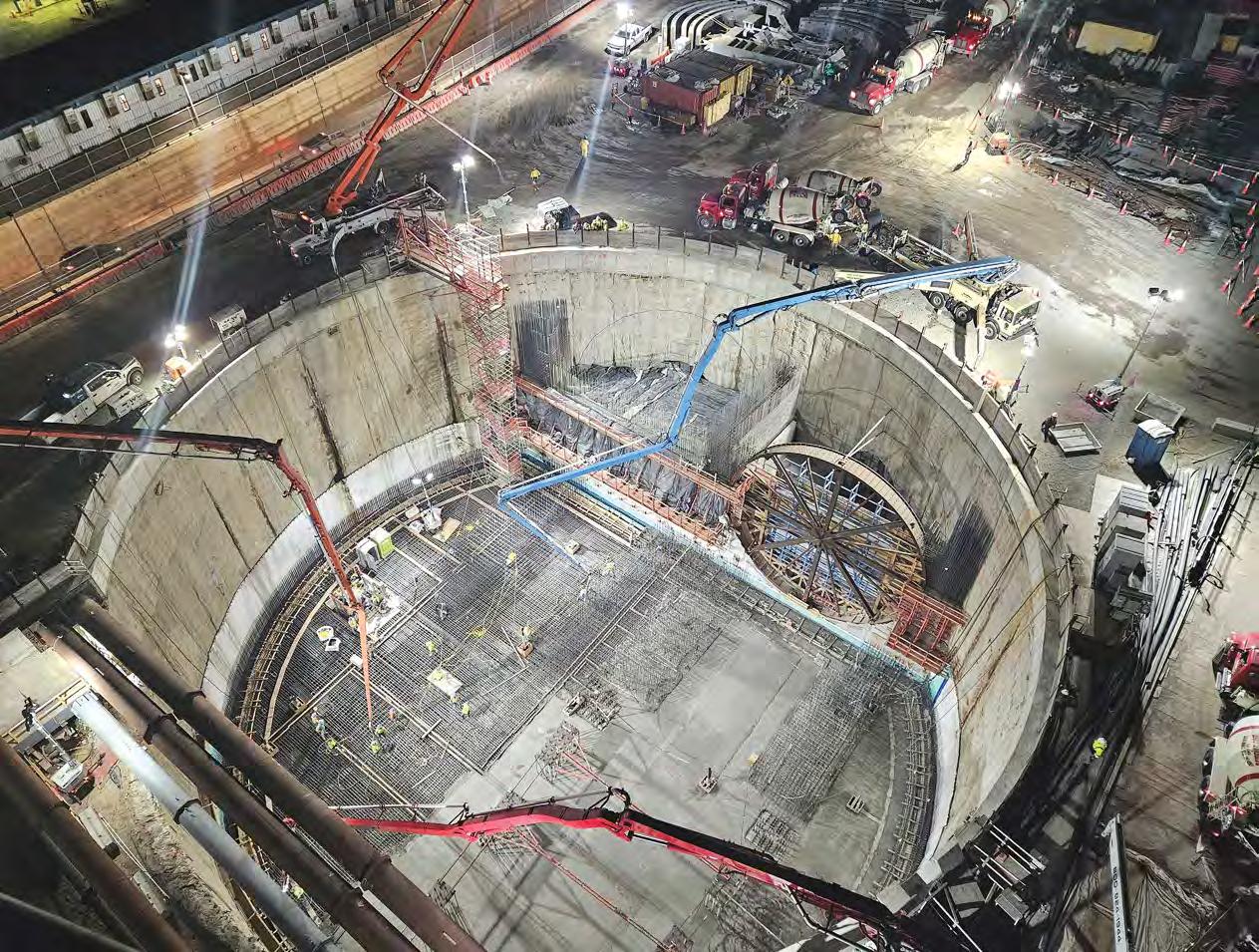
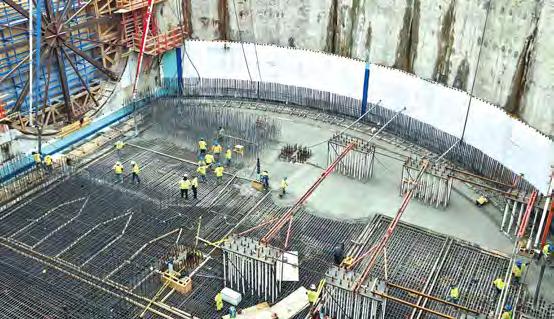
The concrete was unloaded directly into the hopper of one of three concrete pump trucks. Crews in the receiving pit placed the concrete using hoses that pumped concrete directly from the hopper. Because concrete starts to set immediately after it is placed, the concrete for the base slab had to be poured continuously, without stopping, to create one solid base slab.
With the completion of the base slab, crews were able to finalize the headwall in preparation for the TBM breakthrough, as well as the cradle for the TBM to be launched back to the South Island as it builds the second tunnel.
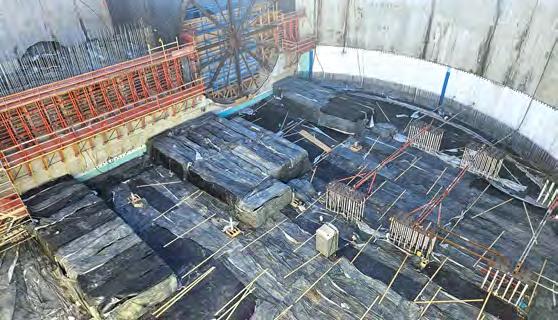
[ 1]: More than 200 people assisted to place 5480 cubic yards of concrete.
[2]: Once the concrete was placed, the entire base slab was covered to allow the concrete to cure. 1 2
Crews installed 1.5 million pounds of rebar to provide the structure needed for the base slab.
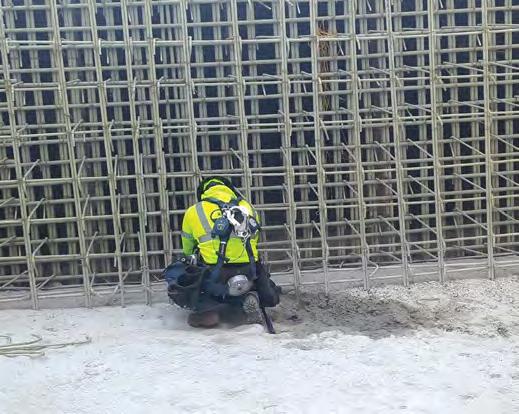
4 3
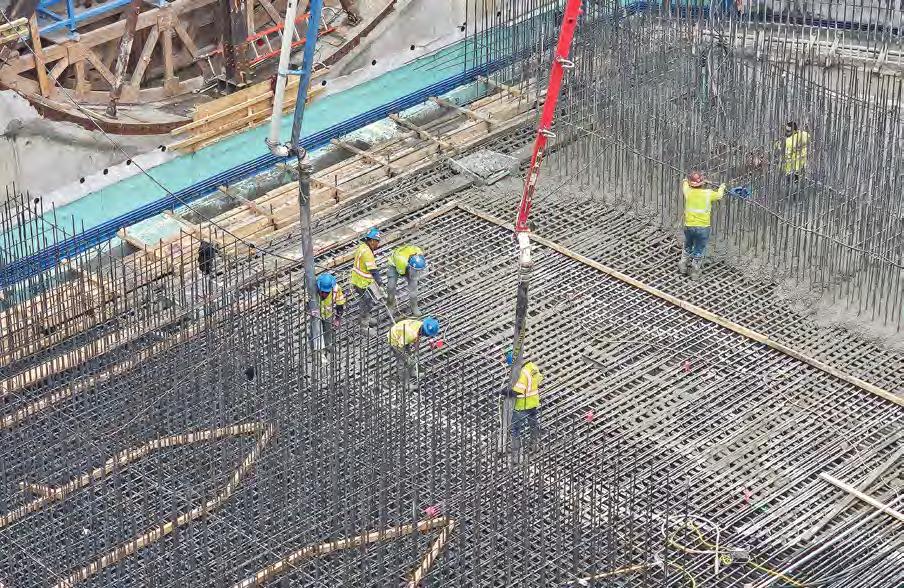
[3]: Rebar had to be placed and tied by hand for the base slab.
[4]: The team used concrete pump trucks to place concrete while workers consolidated the concrete into place to remove any air pockets.
Traffic Shift to New Heights
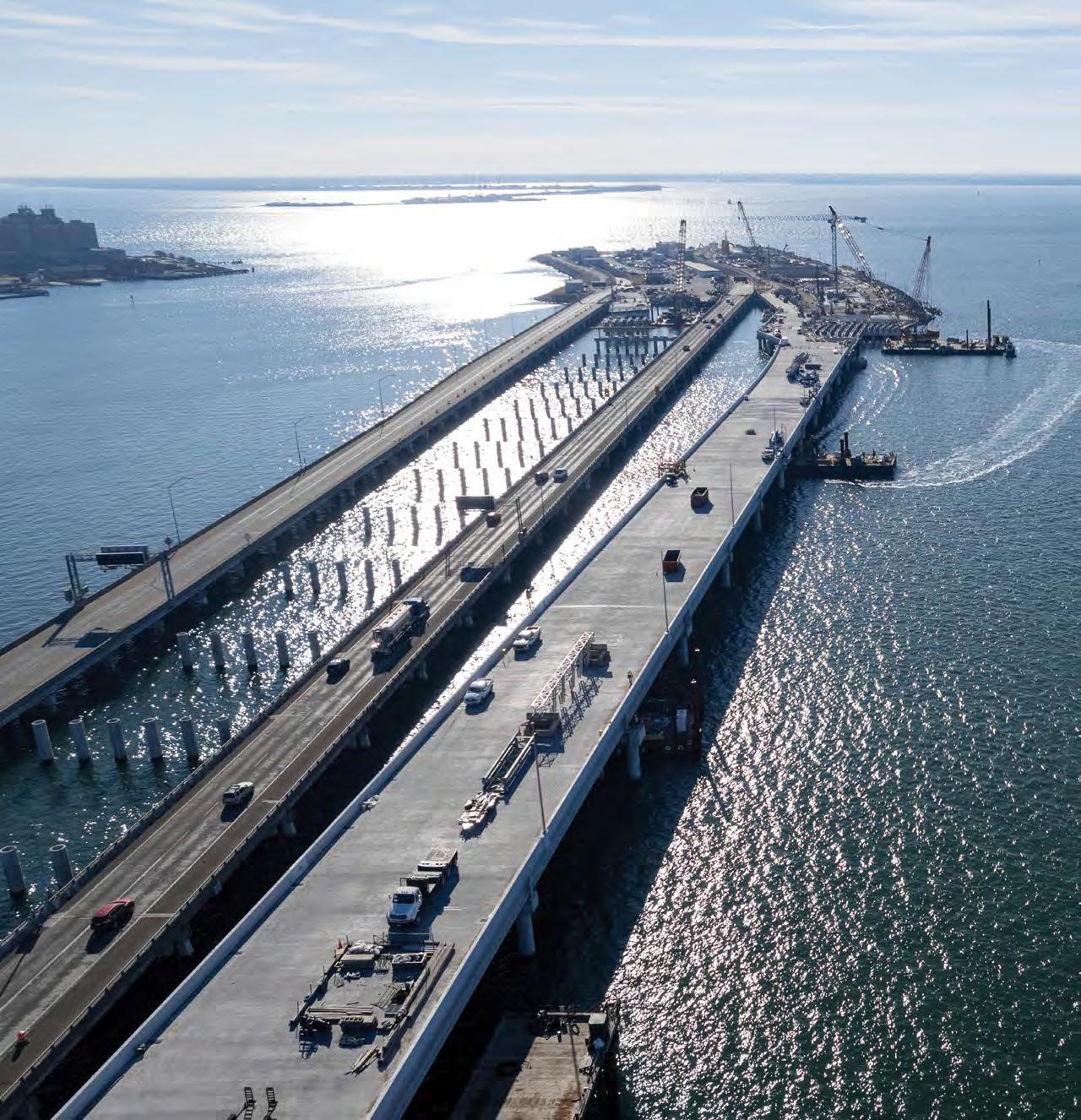
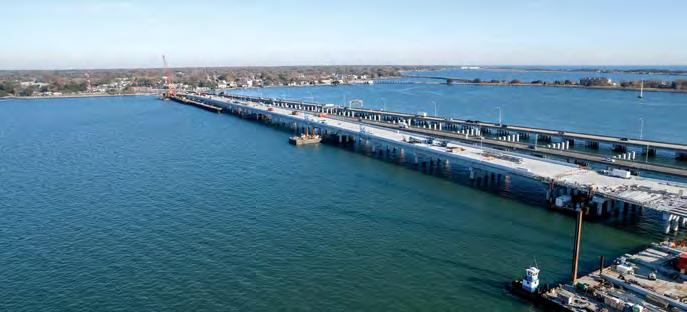
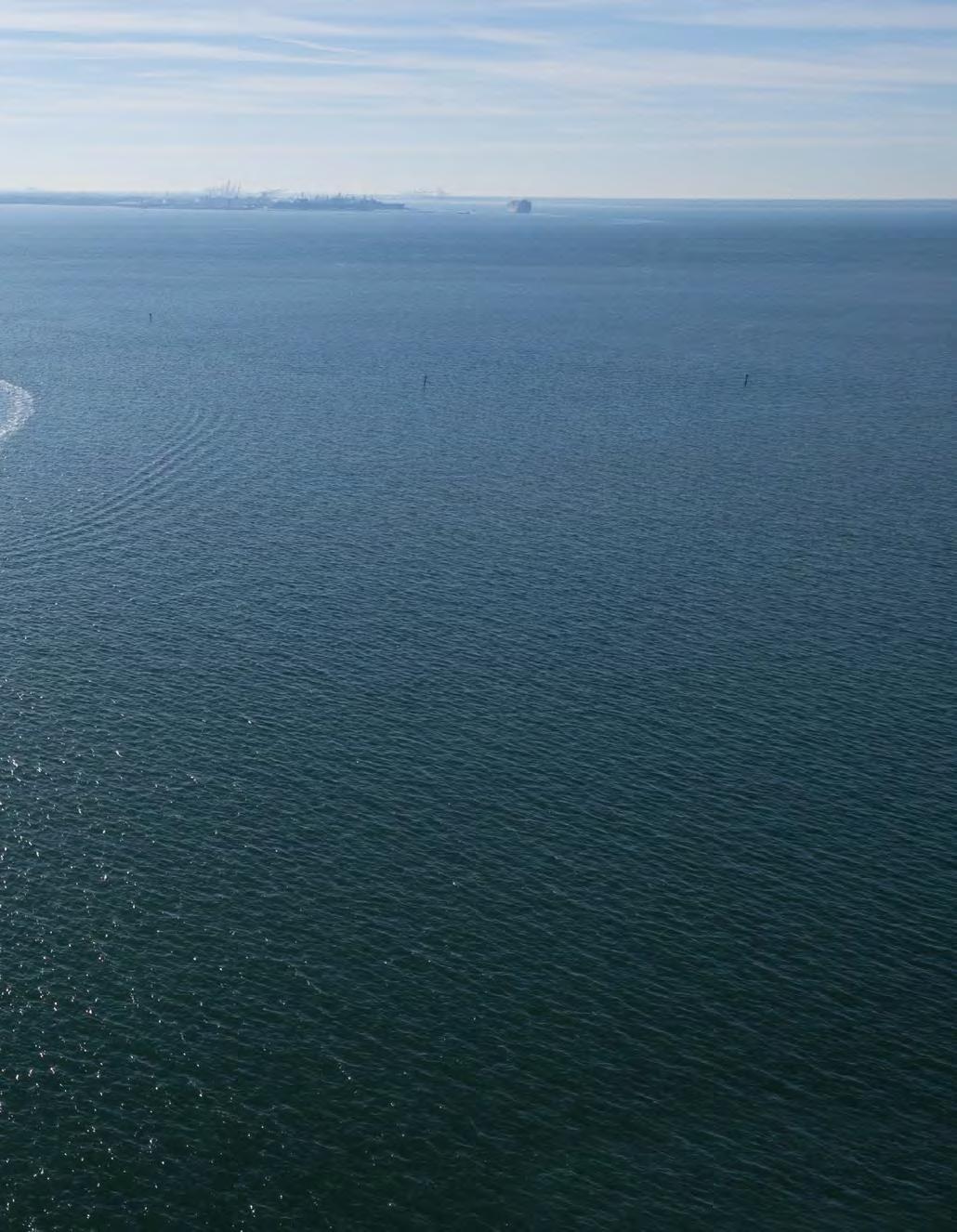

It’s hard to miss the massive new trestle bridges as you drive through the Hampton Roads Bridge-Tunnel. All bridges connecting the tunnels to land will be replaced as part of the HRBT Expansion Project. Connecting the Hampton shoreline to the North Island, the first of two new North Trestle Bridges has taken shape to the west of the existing structures. Crews have worked for the past two years to set the foundation, place the girders and build the bridge deck of the new trestles which will carry all eastbound traffic.




To accommodate the motoring public while keeping the expansion within the existing VDOT right-of-way, construction was planned in multiple phases. Phase 1 is nearly complete as crews get the eastbound North Trestle ready for traffic. As early as spring 2024, this new bridge will be ready for prime time and traffic will be shifted to the new bridge so that crews can demolish the old bridge and prepare for the next phase of construction, in between the existing trestles.
Traveling on I-64 east from Hampton, motorists will be shifted at the shoreline onto this new bridge. The new bridge is six to eight feet higher in elevation than the existing bridge. This accommodates future sea level rise and reduces salt spray hitting the bridge structure. While cars will use the new bridge, they will still use the existing eastbound tunnel tube until the new tunnels are completed.
From Historic to Pre Historic
Throughout the island, shaft, and tunnel construction on the historic HRBT Expansion Project, multiple discoveries have been uncovered in the depths of the seabed. So far on the project, we’ve identified cannonballs and historic shipwreck timbers, both of which are nautical and with the known history of the region would be expected. The latest discovery is a little more unexpected. Bone and tooth fragments from an extinct American Mastodon were recently discovered in Mary’s excavated material.
While tunneling over 50 feet below the sea floor, Mary uses cutting tools to dig and excavate soil in her path. This soil is pumped back to the slurry treatment plant where it is sifted through a trommel and dewatering process before moving down a conveyor belt for eventual disposal.
In September 2023, an observant crewman monitoring the excavated soils noticed something unusual on the conveyor belt. As part of the protocols, he stopped the conveyor belt to take a closer look and discovered fragments that were clearly not soil. These pieces were recovered and evalutated to determine that they belong to a mastodon, which has been extinct for more than 13,000 years. A mastodon is a prehistoric relative of the elephant that went extinct during the last ice age.
The mastodon fragments are relatively small – with one identified tooth and a dozen bone fragments. The next step will be to very carefully dry the bones because they have been sitting in the waterlogged seabed for thousands of years.
Due to the bored tunnel approach and Mary excavating 50+ feet below the seabed, it is difficult to pinpoint and dig for additional pieces of the mastodon. The fragments that were uncovered help us better understand the past, and we’re fortunate to have salvaged these small pieces of history.
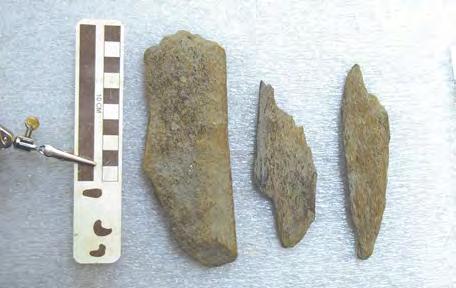
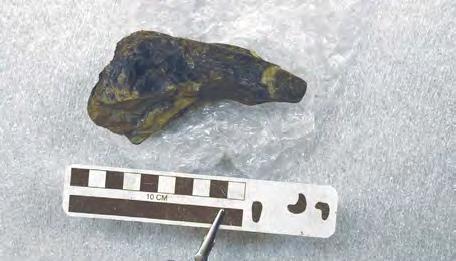

HRBT EXPANSION
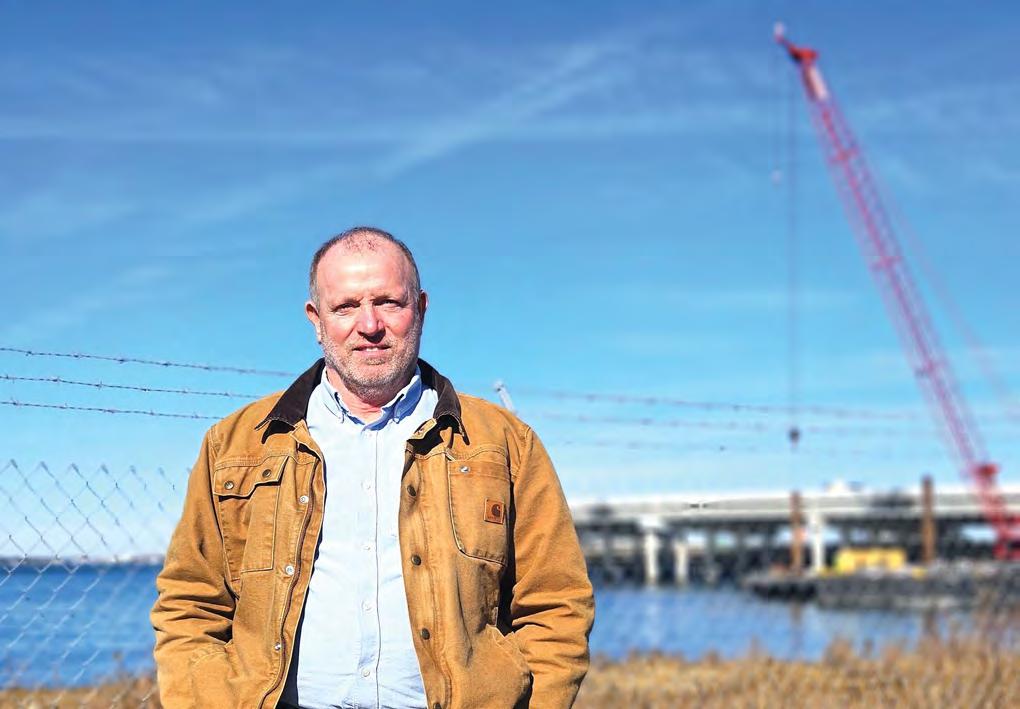
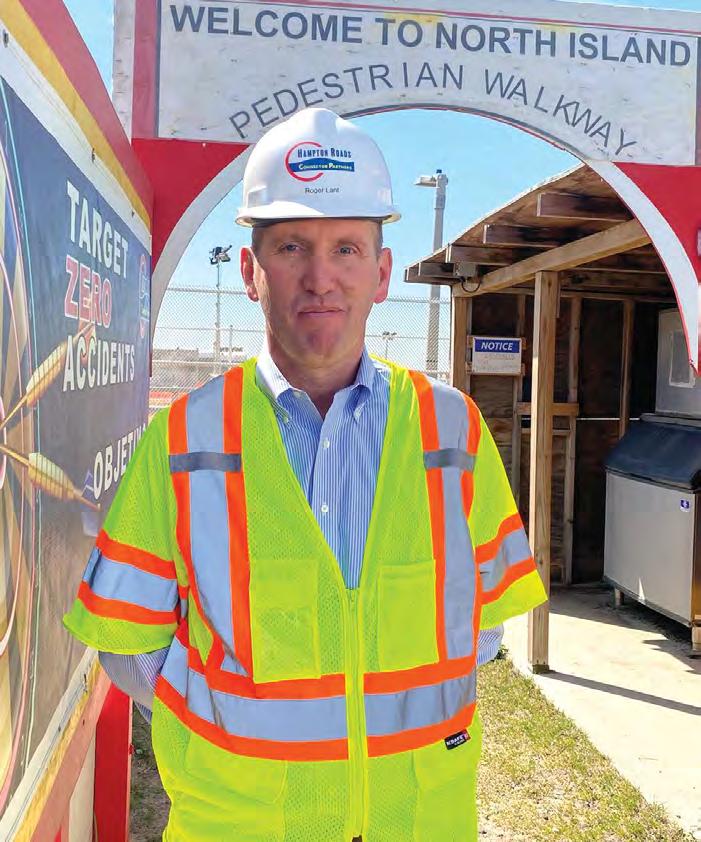
DAN LORD
Resident Engineer, VDOT Marine Trestles & Island Expansion
As a Resident Engineer, Dan Lord is no stranger to bridge and roadway construction. He has managed construction projects for more than 40 years. After starting his career with the New Hampshire Department of Transportation as a construction inspector, Dan was hired by WSP (formerly Parsons Brinckerhoff). He has worked for 30 years managing projects along the Eastern Seaboard, including the Woodrow Wilson Bridge in Maryland/Virginia and the Route 52 Causeway in New Jersey.
He’s excited to work on the HRBT Expansion Project, because of the sheer size and scale of everything. Everything is bigger — from the 54-inch piles to the 85-inch tall beams that make up the marine trestles, and not just one, but four, ringer cranes. This is one project that will be remembered for years to come, and Dan enjoys revisiting his projects to see them in action.

ROGER LANT
Construction Manager, HRCP Landside and Marine
As HRCP Construction Manager, Roger Lant has a big job overseeing the construction efforts for everything on the project except the islands and tunnels. While involved with the HRBT Expansion Project at the leadership level for the last two years, Roger recently assumed the role of full-time Construction Manager in April 2023 overseeing more than 550 team members. Under his purview are the construction and rehabilitation of 25 bridges and overpasses, as well as the widening of five miles of interstate roadway. Pretty much everything except the islands and tunnels.
Roger is very familiar with the Hampton Roads construction scene. He was excited to be part of this world-class project with an international team. What would be a pretty straight forward scope is more challenging due to an extremely tight footprint and neighboring wetlands. The key has been in proactive planning. Roger credits the team who despite the challenges have set record concrete pours and have made great progress over the last year. When he’s not managing the project, Roger is still focused on the HRBT, but from the perspective of the water where he enjoys sailing and hopes to start an HRCP sail team to compete in the local races.
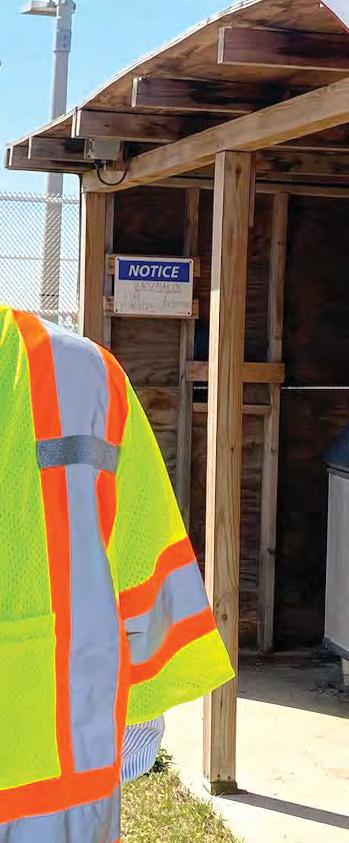
Full STEM Ahead
Encouraging future engineers
The HRBT Expansion Project is a generational project that provides the opportunity to empower the young minds of the future. The project team utilizes community events to engage students, from elementary school to college, and educate on engineering concepts from roadway to bridge to tunnel construction. Throughout the fall, the HRBT Expansion Project team participated in outreach events, reaching tens of thousands of students of all ages across Hampton Roads. Students learned about the progress of the HRBT Project and the use of the tunnel boring machine. They were even able to take home a paper model of the TBM to assemble at home.
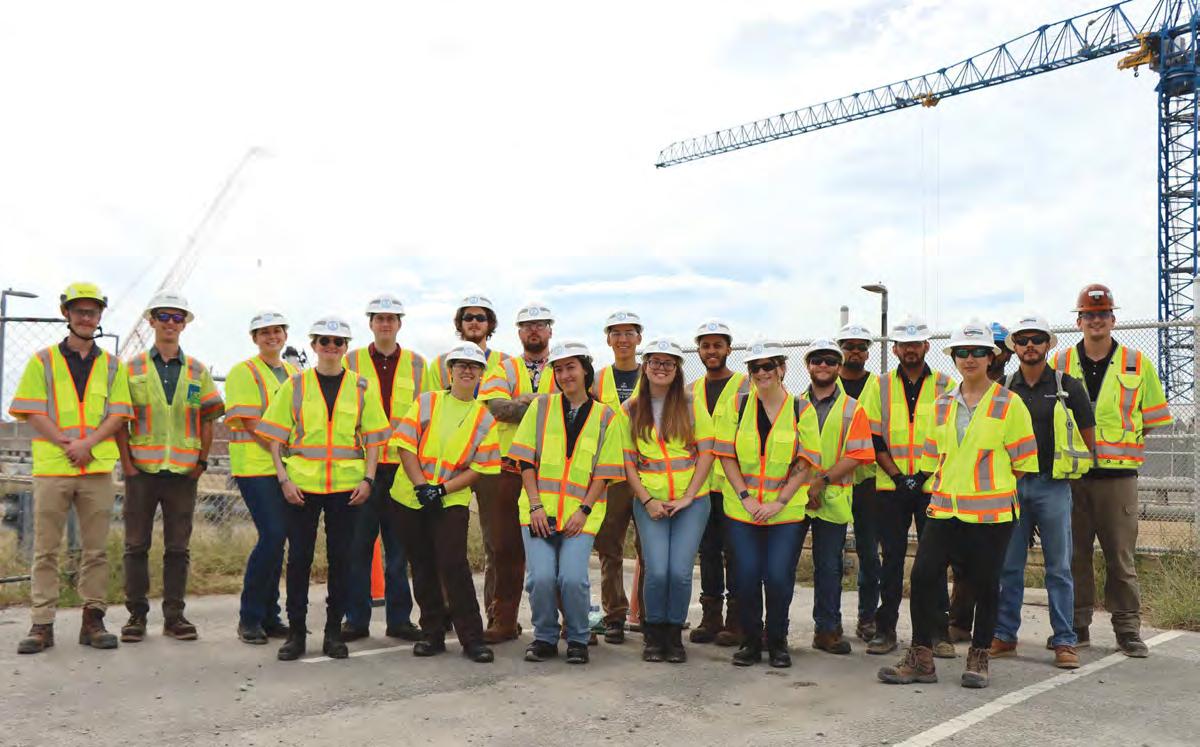
UNDERGROUND CONSTRUCTION ASSOCIATION
Underground Construction Association (UCA) supports professionals in the mining industries. As part of their effort to promote mining career fields, UCA developed a program for college engineering students called “Down for That” to highlight opportunities in the underground construction industry. The students heard presentations about the landside, marine and tunnel work and were able to tour the HRBT Expansion Project to see mining in action with the construction of the new tunnel using the bored tunnel approach.
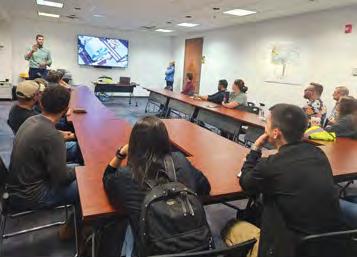


NAS OCEANA AIR SHOW
The NAS Oceana Air Show, a perennial event that commenced in 1973 and, continues to attract a large audience. The weekend begins with a STEM showcase, engaging thousands of students from Virginia Beach City Public Schools, Chesapeake City Public Schools, private schools, and homeschoolers.

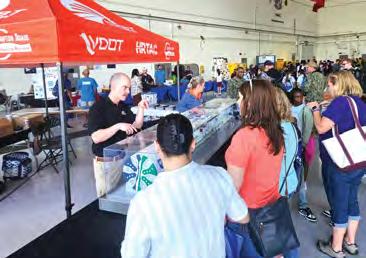

NAVAL STATION NORFOLK FLEET FEST
For the first time since 2019, Naval Station Norfolk brought back Fleet Fest and the STEM Day on October 20, 2023. Nearly 3,000 local students had the opportunity to visit the largest naval installation in the world and participate in more than 45 STEM exhibits, including the HRBT Expansion Project booth where they could interact with a model of Mary, the Tunnel Boring Machine.
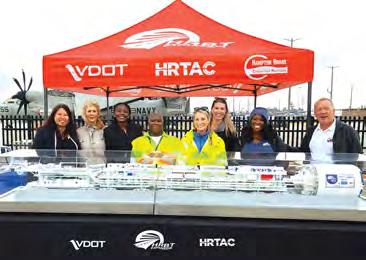

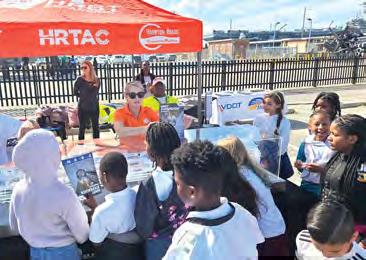
NASA LANGLEY OPEN HOUSE
More than 40,000 people registered to attend the NASA Langley Open House on October 21, 2023. Since the TBM was named after Mary Jackson, it was fitting that NASA Langley invited the HRBT Expansion Project team to be an exhibitor at the event. This was the first time NASA Langley has opened its doors to the public since 2017.
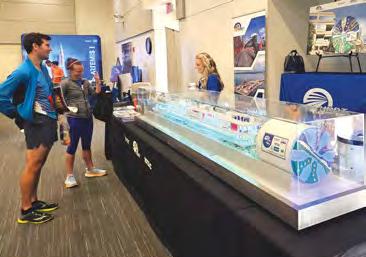
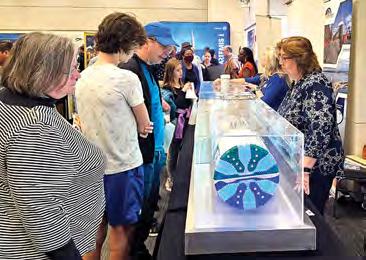
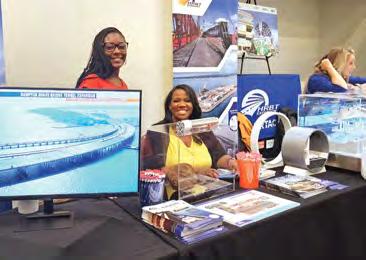
The Final Ring Production
In 2021, a brand new, yet temporary, manufacturing plant was constructed on the Cape Charles waterfront. For two years, this plant operated in two shifts, working day and night, to create the tunnel segments needed for the HRBT Expansion Project. After months of testing concrete, the team perfected the formula for the reinforced concrete needed to create the segments for the new tunnel. This mixture was poured into nine customized molds that were built specifically for the HRBT project. These nine segments would form one ring of the tunnel. The plant housed three sets of molds for a total of 27 segments, or 3 rings, that could be completed during each shift.
Once the concrete is cured, the tunnel segments are moved into the yard to be stored until transported to the South Island. This bi-weekly trek from Cape Charles carries 180 tunnel segments each trip. Over time, the crew ran like a well-oiled machine, working at a remarkable speed to unmold segments completed by the previous shift before starting the process all over again to pour new segments.
Over the period of their eight-hour shift, crews uncover the molds which house the new concrete segments that have been steam curing for hours. After opening up the molds, they move the completed segments
to be finished and transported to the tented area for a second curing. The molds are then cleaned and oiled for the next batch of tunnel segments.
Over in the yard, rows and rows of finished tunnel segments wait for their turn to be transported by barge down the Chesapeake Bay to the South Island where Mary will place each one in her journey to complete the tunnel. Each segment is tracked, with extensive data recorded which includes the results of the quality testing on the concrete, exact date manufactured, identification number and exactly where it is placed in the tunnel.
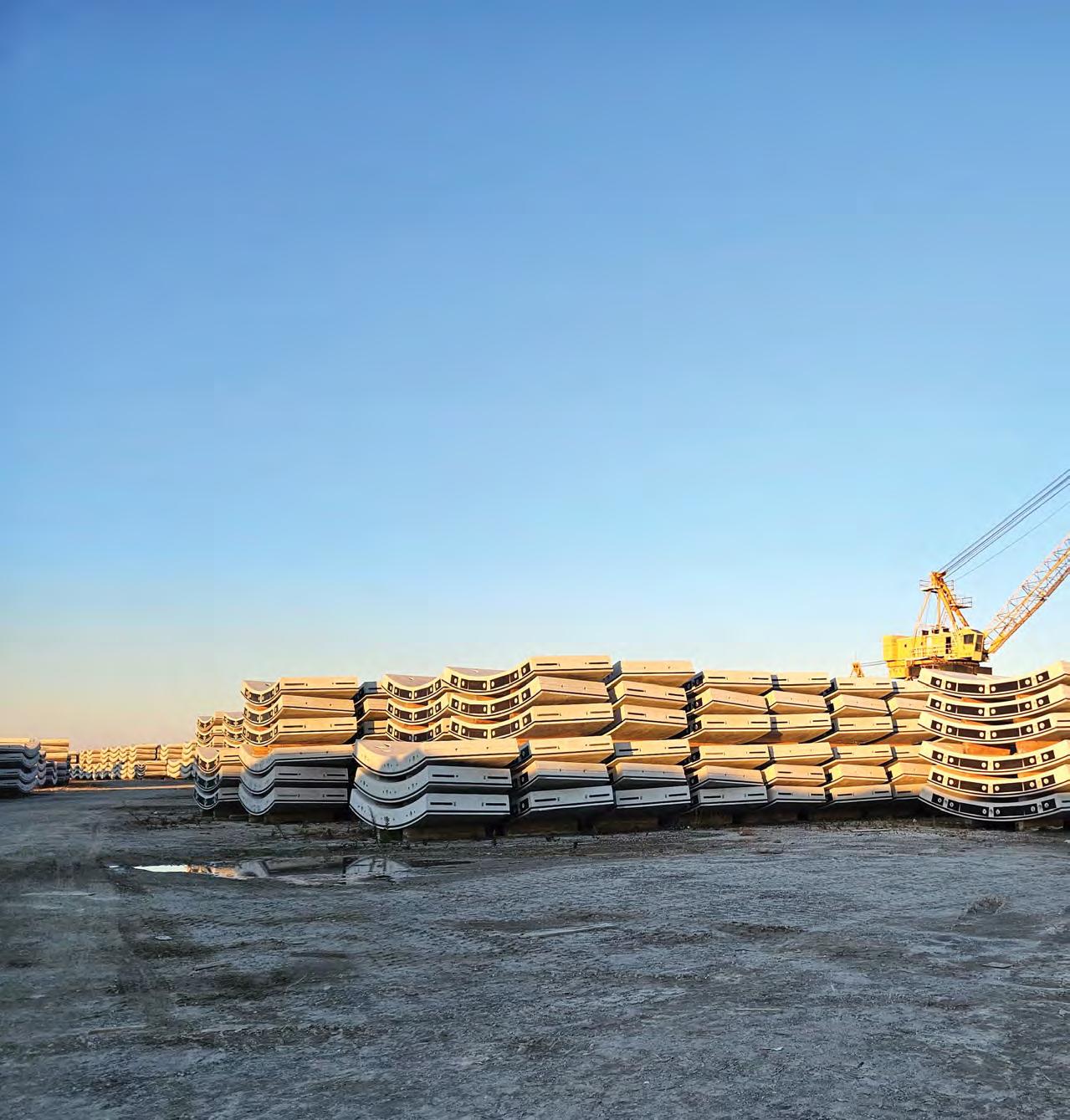
More than 21,000 SEGMENTS have been manufactured to form the two tunnels.
HRBT EXPANSION
In December 2023, the plant manufactured some of the last of the tunnel segments needed for the HRBT Expansion Project. In total, more than 21,000 segments have been manufactured to form the two tunnels.
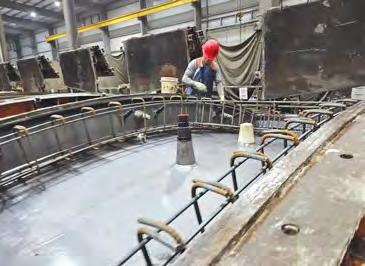
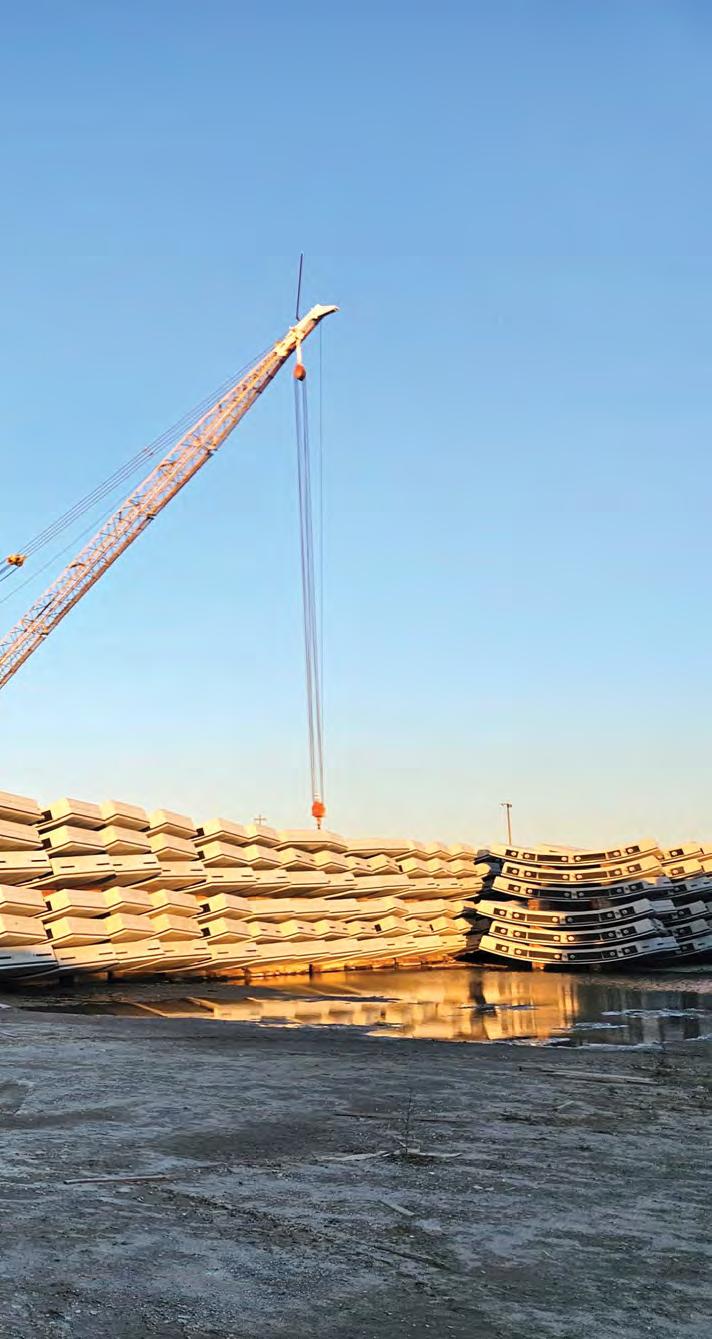
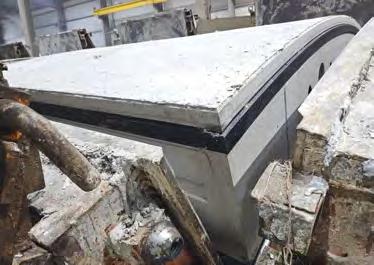
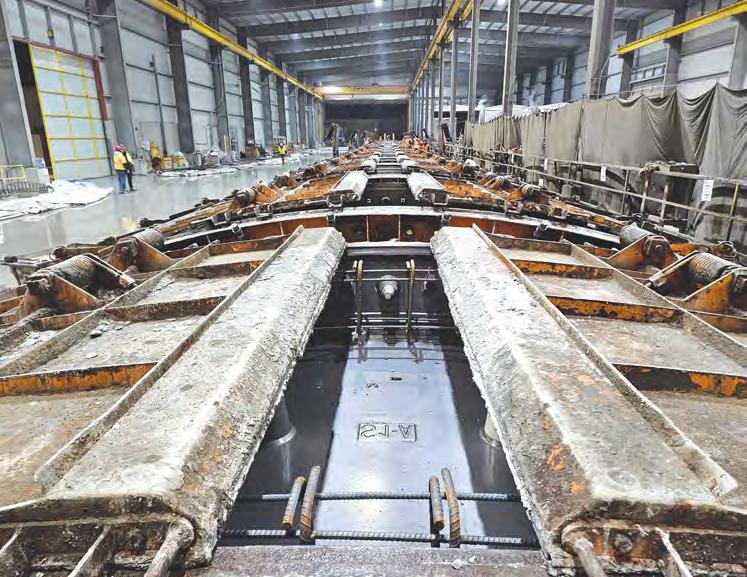


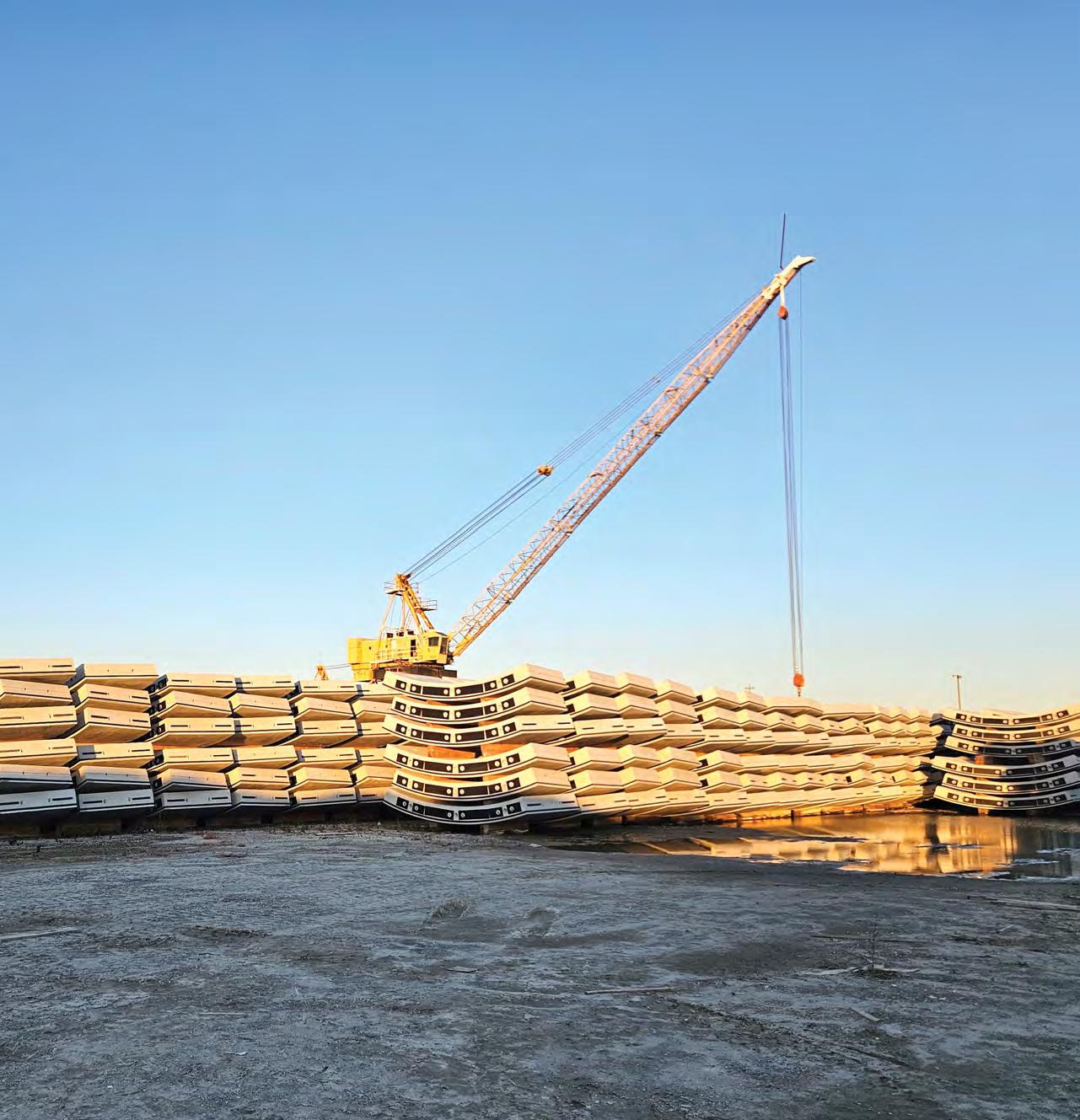
Widening Willoughby Bay Bridge
Initially formed by a hurricane in 1749, Willoughby Spit is a 7.3-mile peninsula surrounded by water, with the Chesapeake Bay on one side and Willoughby Bay on the other. Connecting Interstate 64 from one end of Willoughby Spit to the other is the Willoughby Bay Bridge. Nearly one mile in length, the Willoughby Bay Bridge is being rehabilitated and widened in both directions as part of the HRBT Expansion Project.
Crews completed driving 245, 24-square inch piles and installing the girders needed to widen the eastbound bridge. The concrete bridge deck has been poured for nearly half of the 4,900-foot-long bridge. Crews began pile-driving for the westbound bridge in 2023.
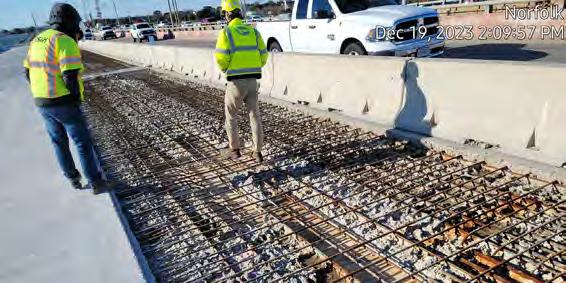
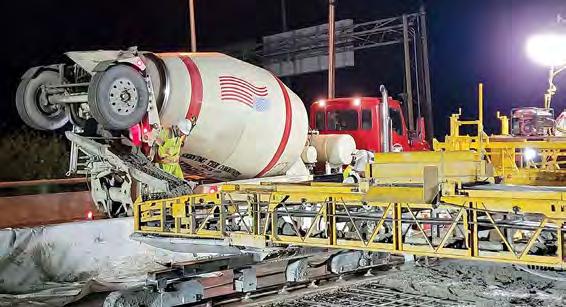
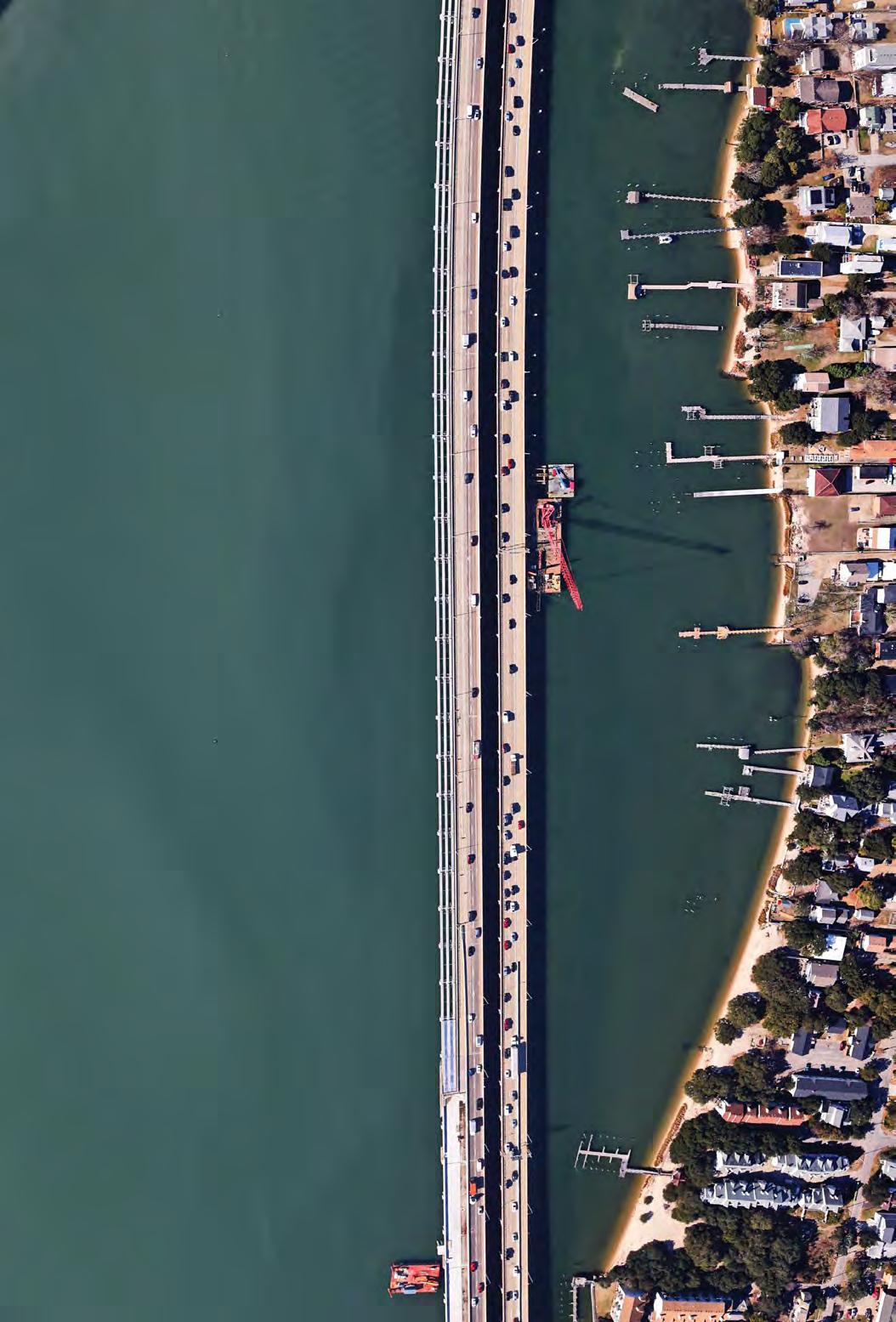
Chesapeake Express Lanes Now Open

Exciting developments are underway on the Hampton Roads Express Lanes (HREL). The future continuous 45mile network of Express Lanes on I-64, extending from east of Denbigh Boulevard in Newport News to the I-664/I-264 Bowers Hill interchange in Chesapeake, is designed to improve travel time, reliability and safety by providing motorists more travel options. From the Bowers Hill interchange through the High Rise Bridge, and extending to the I-264 interchange in Norfolk, the Chesapeake Segment of the Express Lanes opened to traffic in February 2024. These new Express Lanes are identified by new signage, pavement markings, and white posts. Chesapeake Express Lanes are open to traffic, with multiple access and exit points for drivers to navigate in and out of the Express Lanes. Express Lanes will operate 24 hours a day, seven days a week for both this new Chesapeake Segment, as well as the previously existing Norfolk Reversible Express Lanes located between the I-264 and I-564 interchanges. Remember, drivers wanting to use the Express Lanes need an E-ZPass transponder. Solo drivers may use either

a standard E-ZPass or an E-ZPass Flex transponder to pay a toll to use the Express Lanes or continue using the other general purpose lanes for free. Vehicles with two or more passengers can use the Express Lanes for free by using the required E-ZPass Flex transponder switched to “HOV-ON.” To learn more about the Hampton Roads Express Lanes, navigating the Chesapeake Segment, tolling operations, or to get your E-ZPass transponder, visit www.64expresslanes.org/drive.
DRIVING SOLO
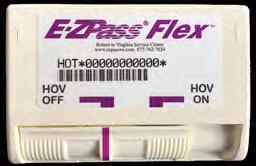
How it works: HOV OFF POSITION

For those riding alone in the Express Lanes, the switch on the E-ZPass Flex must be switched to the HOV-OFF position to be in compliance and pay the posted toll rate. E-ZPass Flex also works like a standard E-ZPass on all other toll roads wherever E-ZPass is accepted, regardless of the position of the switch.
WHERE YOU GET YOUR E-ZPASS FLEX
The E-ZPass transponders can be obtained at various retail locations across Hampton Roads, including the E-ZPass Customer Service Centers and DMV locations.
There are multiple ways that you can exchange your standard E-ZPass transponder for an E-ZPass Flex transponder, including online, via phone or in-person
at an E-ZPass Customer Service Center. Locations include 1701 Church Street in Norfolk and 4010 Victory Boulevard in Portsmouth.
You can also exchange your E-ZPass transponder by visiting www.ezpassva.com or calling 1-877-762-7824 between 7am and 7pm, Monday-Friday.

 HRBT EXPANSION
HRBT EXPANSION
